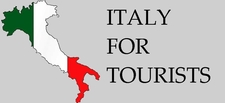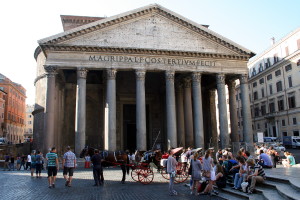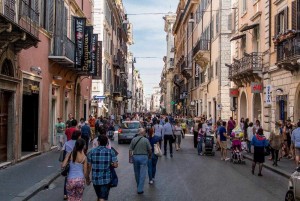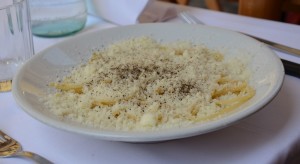Rome
“Methinks I will not die quite happy without having seen something of that Rome of which I have read so much.” – Sir Walter Scott, Scottish novelist
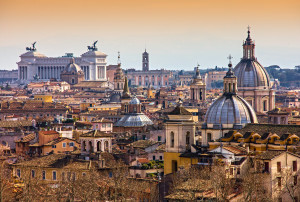 Known as the Eternal City, Rome is the capital of Italy. It is also the most populous and most visited city in the country, and one of the top visited cities in the world. Its history spans nearly 2,500 years, making a visit to this culturally rich metropolis an absolute must. It is regarded as one of the birthplaces of Western civilization, meaning that many of the amenities you enjoy today can be traced back to ancient Rome. If you are flying to Italy on vacation, chances are that you will either fly into or out of Rome, so why not make the most of your visit!
Known as the Eternal City, Rome is the capital of Italy. It is also the most populous and most visited city in the country, and one of the top visited cities in the world. Its history spans nearly 2,500 years, making a visit to this culturally rich metropolis an absolute must. It is regarded as one of the birthplaces of Western civilization, meaning that many of the amenities you enjoy today can be traced back to ancient Rome. If you are flying to Italy on vacation, chances are that you will either fly into or out of Rome, so why not make the most of your visit!
Colosseum
One of Italy’s most famous landmarks, the Colosseum was once the Roman Empire’s largest amphitheatre, where gladiators fought for their lives. Emperors used the Colosseum to entertain spectators with games that lasted for several days. No other landmark better represents the magnificence of the Empire than the Colosseum. Despite its large crowds, especially during the summer, the Colosseum is an absolute must for any visit to Rome. The games were a symbol of prestige, and to this day this landmark embodies Italy’s cultural prestige in equal measure.
Roman Forum
Not far from the Colosseum is the Roman Forum. Once the center of Roman life, it now lacks its former splendor and requires a bit of imagination to get the idea of what it was once like. Nevertheless, the ruins remain a Roman charm, and tourists get quite the feeling walking where Romans once walked 2,000 years ago. Free tours are often offered.
The Pantheon is one of the best-preserved buildings of ancient Rome. Located in the modern shopping district, it was commissioned during the reign of Augustus as a temple to the ancient gods. Today, it is used as a Catholic church.
Vatican City
Functioning as its own independently recognized state, the Vatican is technically not a part of Italy, or even a part of Rome! It is completed surrounded by Rome on all of its borders, so for practical purposes it is often identified as being part of the Italian capital. You can walk directly into Vatican City simply by crossing the street, no visa required! At the center of Vatican City is St. Peter’s Square, which is overlooked by St. Peter’s Basilica, a building of remarkable splendor. The Vatican serves as the home of Roman Catholicism, one of the most influential faiths in the world. It is ruled by the Pope (who also doubles as the Bishop of Rome) and the highest functionaries are Catholic clergymen. On Sundays, tourists will often see the Pope delivering mass, and on Wednesdays he delivers a message of faith to crowds in St. Peter’s Square. The Vatican is also home to the Vatican Museums (Musei Vaticani), which house one the largest and richest art collections there is. A tour of the museums ends with a visit to the Sistine Chapel, whose ceiling was painted by the legendary artist Michelangelo.
Just about every major European city has a main drag, and Rome is no exception. Via del Corso runs right through downtown Rome and is lined with many shops, boutiques, souvenir outlets, cafes and restaurants. On the most glorious of days, it is by far one of the best walking experiences in all of Europe. If you have expensive tastes, Via del Corso intersects Via Condotti, a busy and fashionable street with stores of the world’s most famous designers.
Climb the Spanish Steps
The Spanish Steps are a set of steps at the end of Via Condotti. It is typically flooded by tourists during high season, but a climb atop the steps offers a magnificent view of Rome. At the base of the steps is Piazza di Spagna, one of the most famous squares in Italy. There are several restaurants and food vendors around the steps, and whether you take a seat at a local establishment or grab food on the go, having a meal in the presence of the steps is quite an experience. Antico Caffe Greco, often considered the best coffee in Rome, is only a few steps away.
Throw a Coin in the Trevi Fountain!
Another iconic image of Rome, the Trevi Fountain is one of the most famous fountains in the world. The Baroque-style fountain is located not far from the Spanish Steps and has been featured in many romantic movie scenes. According to tradition, if you throw a coin into the Trevi Fountain you will return to Rome. And who wouldn’t want that?! The coin should be tossed with your back to the fountain, using your right hand to toss the coin over your left shoulder (or vice versa). The basin of the fountain is so big that it’s nearly impossible to miss.
A traditional dish of central Italy, cacio e pepe is a type of spaghetti that translates into “cheese and pepper.” As its name suggests, the ingredients are rather simple. Spaghetti pasta. Black pepper. Pecorino cheese. Because of its simplicity, it is a rather common dish that is known as the poor man’s pasta. But when prepared properly, it is simply one of the best dishes to have in Rome.
Saltimbocca
Saltimbocca is a popular dish composed of veal topped with prosciutto and sage. Translated as “hop in the mouth,” it is often marinated in white wine or oil, depending on one’s preferences. It is served in many places outside of Italy, but there’s nothing like eating it in its native city!
Carciofi
Simply, artichokes. In contrast to other cities worldwide, the artichoke is a common staple in Roman produce. They come into season during late spring and early summer. Carciofi alla romana (or Roman style) is prepared by stuffing artichokes with breadcrumbs, mint and garlic before braising them in olive oil and water.
Trippa
Or tripe. Many Americans may balk at the idea of eating beef tripe, which is composed of a cow’s stomach. But many Americans have probably never had it Roman style. It is cut into small edible pieces and topped with spicy tomato sauce and parmesan cheese. Once you have it, you’ll probably regard a cow’s stomach as exotic cuisine!


